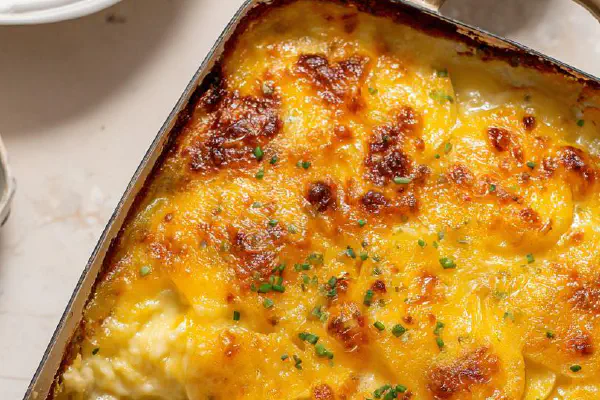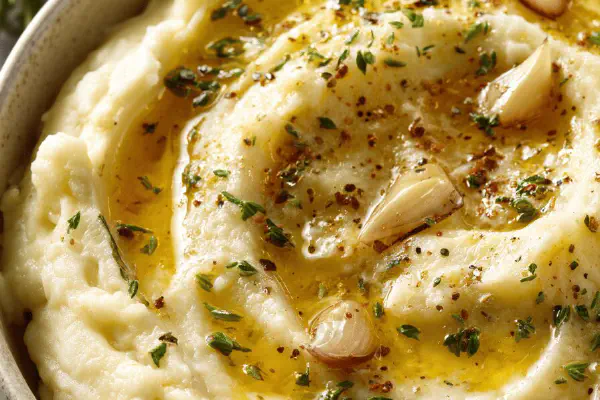Creamy Mashed Potatoes Twist

By Emma
Certified Culinary Professional
Ingredients
- 2 pounds starchy potatoes (Russet or Yukon Gold)
- 1/2 cup heavy cream
- 1/2 cup mushroom stock (sub chicken broth)
- 4 tablespoons unsalted butter
- 1/4 cup Greek yogurt (instead of sour cream)
- Salt
- Freshly cracked black pepper
About the ingredients
Method
Potatoes| Start by scrubbing potatoes well. Cut into roughly equal chunks—don’t worry about size too much but uniformity helps cook evenly. Toss into cold water in a large pot, enough to fully soak them. Starting cold water avoids waxy outsides and mushy centers. Bring slowly to a boil over medium heat. Listen for gentle bubbling, medium rolling boil—too hard will break them down prematurely. After about 15 to 17 minutes (watch your watch loosely), poke with a fork—the tender test. Should slide in with little resistance but not disintegrate.
- Drain potatoes thoroughly in a colander. Shake a little to let steam escape; soggy means watery mash. Let the heat vent a bit while preparing dairy.
Cream and Stock| Microwave your cream and mushroom stock just till warm—roughly 20 seconds depending on wattage. Warm liquids blend in far easier and avoid cooling mash down instantly. Avoid boiling here or separating fats; you want smooth and integrated, not curdled or hot enough to scald potatoes. Room temperature is a lazy fallback but less seamless.
Mash and Blend| Add butter right after draining because residual heat melts it quicker. Then pour in warmed cream and broth. Greek yogurt last—its acidity wakes potatoes but adds silk. Grab a sturdy hand mixer on low or a ricer if you prefer chunk-free. Mix gently just till fluffy but still some graininess. Overbeat and starch activates, gluey glue. Your ears help—gentle hum and no loud splatters means good pace.
Seasoning| Salt gradually, tasting between pinches. Potatoes demand a heavier hand on salt—underdone means bland. Fresh cracked black pepper offers sharper contrast than ground. Foolproof backup: add a touch of garlic powder or chives for zip if flat after resting. Avoid heavy pepper or sour cream substitutes which can mask potato flavor.
Final'| Serve immediately or keep warm covered. If reheating, splash a little warmed cream to regain softness because refrigeration firms mash like a brick. If too runny? Place in sieve over bowl to drain excess moisture for 5-10 minutes before reheating.
Tips & Troubleshooting| Watery mash comes from undercooked potatoes or excess liquid added. Fix by draining and turning down liquid quantities. Lukewarm dairy infusions prevent cold pockets solidifying in mash, maintaining supple mouthfeel. Proper fork test can’t be overstated—poking early yields gluey glue marrow texture. Don’t peel too early; peeling hot potatoes steams skins for easier removal and less wasted potato. Experimented with replacing chicken broth with mushroom stock for umami depth; swap back if you want neutral.
Experience Notes| Once tried blitzing mash with handheld blender, ended in glue. Now I rely on rhythm and sense of touch. This one feels right—fluffy but with just enough bite and body. The Greek yogurt trick is gold after seeing sour cream overshadow subtle potato flavor. The mushroom stock adds earthiness I didn’t know I needed until recent trial. Texture critical; some lumps okay, avoid pureed slime.
Cooking tips
Chef's notes
- 💡 Scrub potatoes well, chunk size flexible but uniform cooks better. Start cold water soak; slow heat avoids waxy outsides and mushy centers. Boil gently. Listen for soft bubbling not roaring boil or potatoes fall apart.
- 💡 Drain thoroughly, shake colander to steam off. Soggy potatoes wreck mash texture and add unwanted water. Heat venting after draining helps dry them out, keeps mash fluffy instead of gluey.
- 💡 Warm heavy cream and mushroom stock gently. Too hot breaks fat emulsion, too cold chills mash instantly. Microwave 20 seconds, adjust wattage watch carefully. No boiling or curdling. Smooth integration matters.
- 💡 Butter goes in right after draining. Residual heat melts it quick. Then warmed liquids, then Greek yogurt last. Yogurt acidity wakes potatoes but adds silkiness without heaviness. Mix low speed hand mixer or ricer. No blitzing or glue forms.
- 💡 Salt aggressively but gradually after mixing. Under salting makes bland mash. Fresh cracked pepper better than ground for sharp punch. Add garlic powder or chives if flavor falls flat. Avoid sour cream substitutes that mask potato.
- 💡 Serve immediately or warm gently covered. Refrigeration firms mash like bricks. Reheat with splash warm cream to regain softness. Too runny? Drain excess moisture in sieve 5-10 minutes before reheating. Texture saves dish.
- 💡 Watery mash comes from undercooking or too much liquid. Drain longer; drop stock quantity. Fork test key — fork slides easily but no falling apart. Avoid peeling before cooking; hot skins slip easier and waste less. Mushy skins means sloppy mash.
- 💡 Avoid handheld blenders or food processors unless you want gluey sticky mess. Texture crucial; lumps ok if soft and silken, puree slime no. Greek yogurt swapped for sour cream adds brightness and subtle tang without heaviness.
Common questions
How to tell if potatoes are done?
Fork slides in easy but no mush. Slight resistance good. Boil softly, listen to bubbling sound, quiet rolling boil is signal. Overcooking makes gluey mash. No timer focus on feel and sight.
Can I swap mushroom stock?
Yes chicken broth or veg broth works. Mushroom stock adds earthiness. If you want neutral, use chicken. Cream warming same for all liquids. Swap yogurt for sour cream if dairy preferred but tang lost.
What if mash is watery?
Drain potatoes well. Don’t add too much liquid. Turn heat down to slow boil. Drain mash in sieve 5-10 minutes before serving or reheating. Lukewarm dairy prevents chilled lumps forming. Fork test prevents water logging.
How to store leftovers?
Store in airtight container refrigerated. Reheat with splash warmed cream or stock to soften or else dries out hard. Cover while warming keeps moist. Can freeze but texture changes, best eaten fresh within 2 days.



